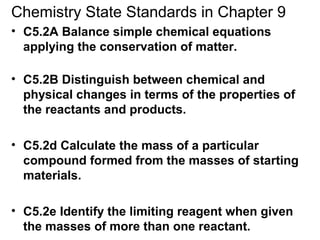
Sec. 9.1 and 9.2 ver 5
- 1. Chemistry State Standards in Chapter 9 • C5.2A Balance simple chemical equations applying the conservation of matter. • C5.2B Distinguish between chemical and physical changes in terms of the properties of the reactants and products. • C5.2d Calculate the mass of a particular compound formed from the masses of starting materials. • C5.2e Identify the limiting reagent when given the masses of more than one reactant.
- 2. Section 9.1: Using Chemical Equations Because atoms are just rearranged (not created or destroyed) in a chemical reaction, we must always balance a chemical equation by choosing the correct coefficients. It is important to recognize that the coefficients in a balanced chemical equation give the relative numbers of molecules, moles, or dozens of molecules, etc. Chapter 9: Chemical Quantities
- 3. Mole Ratio – the ratio of moles of one substance to moles of another substance in the same balanced chemical equation. OR you could say it is the number of moles of one substance divided by the number of moles of another substance in the same balanced chemical equation.
- 4. For instance, the following eqn: 2 H2 + O2 → 2 H2O means 2 moles H2 + 1 mole O2 → 2 moles H2O or 2 molecules H2 + 1 molecule O2 → 2 molecules H2O There are many different mole ratios possible from each eqn, some include: 2 moles H2 1 mole O2 2 moles H2O etc. ________________________ _______________________ _______________________ 1 mole O2 2 moles H2 2 moles H2
- 5. A balanced chemical eqn verifies the law of conservation of matter. To prove this we can look an example: 2 H2 + O2 → 2 H2O To compare the masses of the reactant to the mass of the products, we could write: 2 moles H2 2.0158 g H2 1 mole O2 31.998 g O2 ______________ ________________ ______________ _________________ 1 1 mole H2 1 1 mole O2 2 moles H2O 18.0148 g H2O _________________ _____________________ 1 1 mole H2O 4.0316 g + 31.998 g = 36.0296 g 36.0296 g = 36.0296 g Therefore matter (or mass) is conserved! + →x x x ( () ) )(
- 6. Mole–mole problems – converting moles of one substance to moles of another (this is what we will do in 9-1 Practice Problems). The major types of stoichiometry problems are mass–mass, mass–volume, and volume–volume. (Note: There are other types, but these are the major ones).
- 7. Section 9.2: Solving Stoichiometry Problems Stoichiometry – is the process of using a balanced chemical equation to determine the relative masses of reactants and products involved in a reaction. Mass-mass problems – you are given the mass of one substance and are asked to find the mass of another substance involved in the same chemical reaction.
- 8. Calculating Masses of Reactants and Products for mass–mass problems 1.1. Balance the chemical equation.Balance the chemical equation. 2.2. Convert mass of given substance to moles (theConvert mass of given substance to moles (the given could be a reactant or a product).given could be a reactant or a product). 3.3. Use proper mole ratio to convert fromUse proper mole ratio to convert from moles of “given” substance to moles of “wanted”moles of “given” substance to moles of “wanted” substance.substance. 4.4. Then convert moles of “wanted” substance toThen convert moles of “wanted” substance to grams of that substance.grams of that substance.
- 9. After you balance the chemical reaction and have identified the “given” and the “wanted” substances, you can use the following template to complete the calculation. g “given” 1 mole “given” # mol “wanted” # g “wanted” = _____________________ ___________________________________ ______________________________________ _________________________________ # g “given” # mol “given” 1 mol “wanted" g “given” ÷ molar mass x molar x molar mass = final of “given” ratio of “wanted” answer
- 10. Working a Stoichiometry ProblemWorking a Stoichiometry Problem 6.50 grams of aluminum reacts with an excess of oxygen. How many grams of aluminum oxide are formed? 1. Identify reactants and products and write the balanced equation. Al + O2 Al2O3 b. What are the reactants? a. Every reaction needs an arrow. c. What are the products? d. What are the balanced coefficients? 4 3 2
- 11. Working a Stoichiometry ProblemWorking a Stoichiometry Problem 6.50 grams of aluminum reacts with an excess of oxygen. How many grams of aluminum oxide are formed? 4 Al + 3 O2 → 2Al2O3 = 6.50 g Al ? g Al2O3 1 mol Al 26.98 g Al 4 mol Al 2 mol Al2O3 1 mol Al2O3 101.96 g Al2O3 6.50 x 2 x 101.96 ÷ 26.98 ÷ 4 = 12.3 g Al2O3